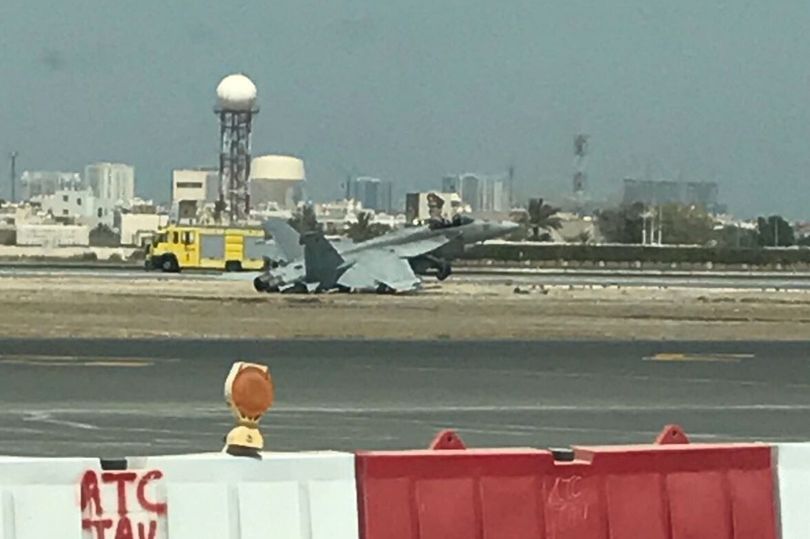Yet another “Rhino” has crashed. It’s the second Super Hornet this year, the fourth one since May 2016.
As you probably already know, an F/A-18E of Strike Fighter Squadron (VFA) 146 assigned to the USS Nimitz (CVN 68) departed the runway and the pilot ejected during an emergency landing at Bahrain International Airport on Aug. 12, 2017.
According to the statement released by the U.S. Navy, the F/A-18E experienced an engine malfunction during a mission launched from USS Nimitz and attempted to divert to Sheik Isa Air Base, Bahrain. Unable to make it to Isa, the pilot was forced to make an emergency landing at Bahrain International Airport. Due to the malfunction, the aircraft could not be stopped on the runway and the pilot ejected from the aircraft as it departed the runway.
The pilot is uninjured and the mishap is under investigation.
This is all we know about this incident. However, it’s worth of note that the one in Bahrain is the 11th major incident involving an F/A-18 of any variant since May 2016 (the figure includes two international incidents: a Swiss Air Force Hornet lost on Aug. 29, 2016 and the Canadian CF-188 lost on Nov. 28, 2016).
Dealing with the F/A-18E/F Super Hornet fleet, four aircraft were lost (fortunately resulting in 0 fatalities) including the one lost last week: two VFA-211 F/A-18F jets from NAS Oceana collided and crashed 25 miles E of the Oregon Inlet, Nags Head, NC on May 26, 2016; earlier this year, on Apr. 21, 2017, a VFA-137 F/A-18E crashed during a landing attempt on USS Carl Vinson (CVN 70) in the Celebes sea, between Indonesia and the Philippines.
Legacy Hornets are crashing at an even more alarming rate: two U.S. Marine Corps F-18 Hornets from MCAS Miramar crashed on Nov. 9, 2016 near San Diego. Another F/A-18C crashed near USMC Air Ground Combat Cente, Twentynine Palms, on Oct. 25, 2016. A U.S. Navy F/A-18C belonging to the Strike Fighter Wing Pacific, Detachment Fallon, crashed on Aug. 2, 2016, 10NM to the south of NAS Fallon. On Jul. 27, 2016 a USMC F/A-18 belonging to the 3rd Marine Aircraft Wing crashed during a night strafing run on a weapons range near Twentynine Palms (killing the pilot). On Jun. 2 a Blue Angels Hornet crashed after taking off from Smyrna/Rutherford County Airport (KMQY), Smyrna, Tennessee: the only pilot on board was killed in the incident.
Aircraft may crash for a variety of reasons, not always technical ones. Still, the rate of Hornet crashes in the last years seems to be unusual and, as such, concerning.
According to a report published in September 2016 by Stars and Stripes, since 2012, the number of major Navy and Marine Hornet and Super Hornet accidents have increased by 44 percent as a consequence of sequestration and subsequent cuts in flight hours for training at home.
Moreover, F/A-18 Hornets of all variants have shown a steady yearly increases of what the Navy calls “physiological episodes” due to oxygen deprivation and cabin decompression since May 1, 2010, and the U.S. Navy has linked the deaths of four Hornet pilots that occurred over a span of 10 years to “physiological episodes” (PE). Such deadly incidents are not all the direct result an oxygen system failure but are linked by the fact that pilots experienced various symptoms that fall within the scope of a PE: dizziness, vertigo, oxygen shortage, blackouts, etc.
Older versions of the plane, the A through D models, have problems with cabin pressure whereas the newer Super Hornet and Growler issues “would appear to point to the onboard oxygen generating” system to which the Navy’ has already made changes.
Although investigators were able to offer several steps to mitigate the risk of physiological episodes, they were not able to identify the root cause of a problem yet.
Top image credit: Twitter via USNI













